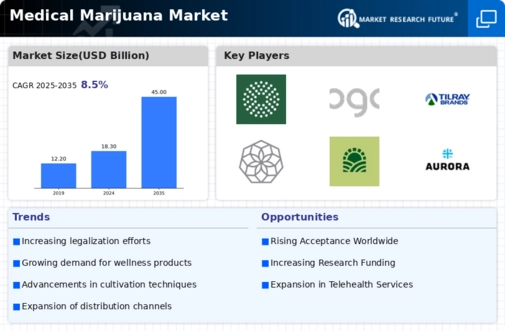The Global Medical Marijuana Market has been experiencing significant growth and transformation over the past few years due to changing regulations, increased acceptance of cannabis for medical use, and expanding therapeutic applications. As more countries legalize medical marijuana, the competitive landscape becomes increasingly dynamic, with numerous players vying for market share. Companies in this sector are focusing on innovative cultivation techniques, product development, and strategic partnerships to enhance their offerings and meet the growing demand from patients and healthcare providers.
Additionally, competition extends beyond product availability, encompassing branding, distribution channels, and consumer education, which ultimately plays a crucial role in shaping the market's trajectory. Given the multifaceted challenges and opportunities within this market, organizations must continuously adapt their strategies to maintain a competitive edge while ensuring compliance with evolving regulations.
Trulieve has established itself as a formidable player in the Global Medical Marijuana Market through a robust operational model and a strong geographic presence. The company leverages its extensive cultivation and production facilities to deliver a diverse range of high-quality cannabis products, including oils, concentrates, and flower. Trulieve's commitment to customer-centric service is evident in its patient education initiatives, which aim to enhance understanding and access to medical marijuana therapies. Furthermore, the company's strategic focus on expanding its footprint in key regions has augmented its presence in traditional and emerging markets.
Trulieve's competitive strengths lie in its established brand loyalty, sophisticated supply chain management, and a reputation for producing reliable, lab-tested products, which further bolster its standing in an increasingly crowded marketplace.
Aphria, operating on a global scale, is also a significant competitor in the Medical Marijuana Market, known for its extensive portfolio of products designed to meet diverse patient needs. The company specializes in a range of high-quality cannabis offerings, including oils, capsules, and other delivery methods, ensuring accessibility for various therapeutic applications. Aphria has strategically positioned itself within the market, not only through organic growth but also via mergers and acquisitions that have bolstered its market presence and expanded its product lineup. This proactive approach enables the company to scale operations efficiently while remaining agile in responding to market trends.
With strengths in research and development, customer service, and a strong ethos surrounding quality assurance, Aphria continues to innovate within the global landscape, ensuring it remains a key player in the evolving Medical Marijuana Market.



 Source: Primary Research, Secondary Research, Market Research Future Database and Analyst Review
Source: Primary Research, Secondary Research, Market Research Future Database and Analyst Review 













Leave a Comment